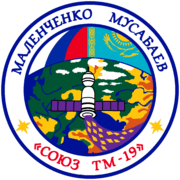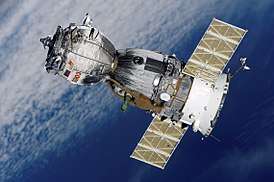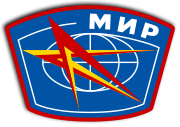Soyuz TM-19
The Soyuz-TM crew transports (T - транспортный - Transportnyi - meaning transport, M - модифицированный - Modifitsirovannyi - meaning modified) were fourth generation (1986–2002) Soyuz spacecraft used for ferry flights to the Mir and ISS space stations. It added to the Soyuz-T new docking and rendezvous, radio communications, emergency and integrated parachute/landing engine systems. The new Kurs rendezvous and docking system permitted the Soyuz-TM to maneuver independently of the station, without the station making "mirror image" maneuvers to match unwanted translations introduced by earlier models' aft-mounted attitude control.
| Mission type | Mir crew transport |
|---|---|
| Operator | Rosaviakosmos |
| COSPAR ID | 1994-036A |
| SATCAT no. | 23139 |
| Mission duration | 125 days, 22 hours, 53 minutes, 36 seconds |
| Orbits completed | 1,993 |
| Spacecraft properties | |
| Spacecraft | Soyuz 7K-STM No.68[1] |
| Spacecraft type | Soyuz-TM |
| Manufacturer | RKK Energia |
| Launch mass | 7,150 kilograms (15,760 lb) |
| Crew | |
| Crew size | 2 up 3 down |
| Members | Yuri Malenchenko Talgat Musabayev |
| Landing | Ulf Merbold |
| Callsign | Ага́т (Agat - Agate) |
| Start of mission | |
| Launch date | July 1, 1994, 12:24:50 UTC |
| Rocket | Soyuz-U2 |
| Launch site | Baikonur 1/5 |
| End of mission | |
| Landing date | November 4, 1994, 11:18:26 UTC |
| Landing site | 88 kilometres (55 mi) northeast of Arkalyk |
| Orbital parameters | |
| Reference system | Geocentric |
| Regime | Low Earth |
| Perigee altitude | 396 kilometres (246 mi) |
| Apogee altitude | 397 kilometres (247 mi) |
| Inclination | 51.6 degrees |
| Period | 92.48 minutes |
| Epoch | 31 July 1994[2] |
| Docking with Mir | |
| Docking port | Kvant-1 aft |
| Docking date | 3 July 1994, 13:55:01 UTC |
| Undocking date | 4 November 1994, 08:31:30 UTC |
 Soyuz programme (Crewed missions) | |
Soyuz TM-19 was the tenth expedition to the Russian Space Station Mir.
Crew
| Position | Launching crew | Landing crew |
|---|---|---|
| Commander | First spaceflight | |
| Flight Engineer | First spaceflight | |
| Research Cosmonaut | None | Third and last spaceflight |
Mission highlights
Commander Malenchenko and Flight Engineer Musabayev, spaceflight rookies, were to have been launched with veteran cosmonaut Gennadi Strekalov, who would have returned to Earth with Viktor Afanaseyev and Yuri Usachyov in Soyuz-TM 18 after a few days on Mir. However, cancellation of one of two Progress-M cargo ships scheduled to resupply Mir during the Agat crew's stay meant Strekalov's couch had to carry supplies. The result was an unusual all-rookie flight. Docking occurred without incident on July 3. On November 3, Musabayev, Malenchenko, and Merbold undocked in Soyuz-TM 19 and backed 190 m from Mir. They then activated the Kurs automatic approach system, which successfully redocked the spacecraft. The cosmonauts then transferred back to Mir. The test was related to the difficulties Soyuz-TM 20 and Progress-M 24 experienced during their automatic approaches. Final undocking and reentry the following day occurred without incident.
Mission accomplishments
- Docked with Mir
- Exchange part of crew
- Conducted medical experiments
- Conducted materials experiments
- Both cosmonauts perform EVA 09.09.1994 (5h 6m) to repair station's external insulation
- Both cosmonauts repeat EVA on 14.09.1994 (6h 1m) for same purpose
- First successful manual docking of a Progress supply ship
Notes
- McDowell, Jonathan. "Launch Log". Jonathan's Space Page. Retrieved 9 November 2013.
- McDowell, Jonathan. "Satellite Catalog". Jonathan's Space Page. Retrieved 9 November 2013.
Both cosmonauts and Doctor Valeri Polyakov (arrived on Soyuz TM-18) became the 16th resident crew; many technical problems with the station arose during this mission, necessitating a previously untried manual supply dock by Malenchenko.

